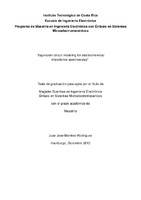Equivalent circuit modeling for electrochemical impedance spectroscopy
Resumen
The design and fabrication of implantable neural electrodes is a challenge,
because the materials and interfaces must provide low impedance to the tissues,
with high current injection capabilities. In the Institute of Optical and Electronic
Materials, researchers have found a way to structure thin layers of conductive
polymers on top of gold electrodes, improving the interface between metal and
tissues. This thesis deals with the electrical characterization of metallic electrodes
coated with thin layers of PEDOT:PSS. A set of 96 individual electrodes with
different surface area and polymer thickness was measured by electrochemical
impedance spectroscopy. The goal of the present thesis is to develop an equivalent
model for the metal/polymer/tissue interface, and fit the experimental data to this
model to explore the different capacitances and resistances of the interface. A total
of six models were obtained from literature, and they were implemented to fit the
data using standard commercial tools such as MEISP from Kuhmo Petrochemical,
or LEVMW from J.R. Macdonald. The main conclusion is that the polymer/solution
capacitance, also called the double-layer capacitance, increases linearly with
the thickness of the polymeric layer, and it is higher than the metal/polymer
capacitance.
Descripción
Proyecto de Graduación (Maestría en Electrónica) Instituto Tecnológico de Costa Rica, Escuela de Ingeniería Electrónica, 2013.


